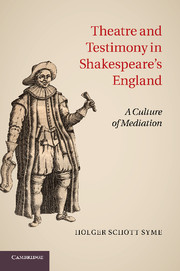Book contents
- Frontmatter
- Contents
- Illustrations
- Acknowledgments
- Textual note
- Abbreviations
- Introduction: The authenticity of mediation
- Chapter 1 Trial representations
- Chapter 2 Judicial digest
- Chapter 3 Performance anxiety
- Chapter 4 Royal depositions
- Chapter 5 The reporter’s presence
- Epilogue: The theatre of the twice-told tale
- Select bibliography
- Index
- References
Chapter 5 - The reporter’s presence
narrative as theatre in The Winter’s Tale
Published online by Cambridge University Press: 05 March 2012
- Frontmatter
- Contents
- Illustrations
- Acknowledgments
- Textual note
- Abbreviations
- Introduction: The authenticity of mediation
- Chapter 1 Trial representations
- Chapter 2 Judicial digest
- Chapter 3 Performance anxiety
- Chapter 4 Royal depositions
- Chapter 5 The reporter’s presence
- Epilogue: The theatre of the twice-told tale
- Select bibliography
- Index
- References
Summary
Deferral may be the central theme of the historical episode Richard II represents as well as of the play and the early modern historiographical project itself. Shakespeare’s last plays, by contrast, have been widely portrayed as thriving on a kind of wondrous presence, as offering unmediated access to the marvellous. The Winter’s Tale in particular is often characterized as a triumph of visual theatre. Its redemption plot appears to culminate in a stunning scene of theatrical amazement, the springing to life of a statue – a scene that allowed early modern audiences to witness with their own eyes a spectacle with which they were familiar from classical mythology and literature (most famously, the Pygmalion episode in Ovid’s Metamorphoses). T. G. Bishop has argued that in his reliance on such a spectacular effect, Shakespeare issues a kind of dramatic dare, ‘risk[ing] more’ than in any other of his works: ‘no other play brings the pressure of an entire structure to bear on its conclusion in quite this way’. The central importance of the statue scene to the play is a critical commonplace. Yet Simon Forman’s diary entry on a performance of the play at the Globe in May 1611 makes no mention of that climactic moment; instead, he describes the reunion of Leontes and his daughter Perdita as the end-point of The Winter’s Tale’s main plot-line, recalling it as a quasi-forensic scene: ‘and the sheppard hauing showed the letter of the nobleman by whom Leontes sent a was [away?] that child and the jewells found about her, she was knowen to be Leontes daughter and was then 16 yers old’. Arguably that is the moment that would have struck early modern audiences as the play’s climax. As Stephen Orgel points out,
for Shakespeare’s age, the restoration of Perdita is the crucial element; even Hermione says she has preserved herself to see Perdita, not Leontes. . . . The tragic loss that Perdita represents is not the loss of her company, or of the opportunity to watch her grow, or of the role we believe her parents should have had in the formation of her character, but the loss of an heir, as the oracle says: ‘the King shall live without an heir if that which is lost be not found’. That is what is found, the essential thing.
If Orgel is right, however, the plot’s most vital moment falls short of the play’s supposed daring theatricality: despite what Forman’s account suggests, Shakespeare does not stage the crucial father-and-child reunion, but has three gentlemen deliver their several, differently informed reports of it. As David Bevington has recently put it, the dramatist thus conveys ‘a sense of wonderment so inexpressively moving that we as audience are asked to imagine rather than actually see what it must have been like’. Such a displacement of authorial or theatrical representational power onto the audience’s own powers of imagination is anything but new in Shakespeare, of course. As I argued in Chapter 3, a deep consciousness of the theatre’s mimetic inadequacy was a staple of his art, most explicitly and famously demonstrated in the prologue to Henry V. But The Winter’s Tale’s penultimate scene appears like a particularly egregious display of this strategy of deferral – so egregious that critics have frequently argued that the true explanation for the apparent cop-out is to be sought in Shakespeare’s playwrighting savvy: he fails to stage Leontes’ and Perdita’s recognition scene, the argument goes, in order to avoid upstaging the play’s true theatrical coup, the resurrection of Hermione.
- Type
- Chapter
- Information
- Theatre and Testimony in Shakespeare's EnglandA Culture of Mediation, pp. 205 - 256Publisher: Cambridge University PressPrint publication year: 2011



